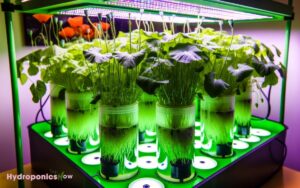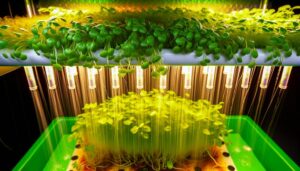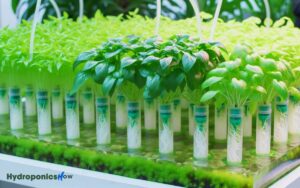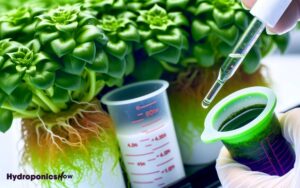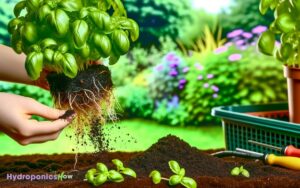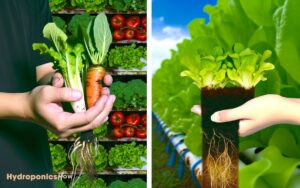Hydroponics Is the Science of Growing Terrestrial Plants in
Hydroponics is the science of growing terrestrial plants in nutrient-rich water solutions without soil, greatly enhancing growth rates and yield efficiency. Research shows that hydroponic systems can accelerate plant growth by up to 50% and increase yield per unit area by up to 90% compared to traditional soil cultivation.
Essential nutrients, balanced macronutrients (N, P, K) and micronutrients (Fe, Mn, Zn), and ideal pH levels between 5.5 and 6.5 are vital for effective plant growth. Furthermore, hydroponics uses up to 90% less water, mitigates soil-borne diseases, and supports sustainable urban farming initiatives.
For deeper insights, explore further.

Key Takeaways
- Hydroponics allows plants to grow in nutrient solutions without soil, enhancing growth rates and yields.
- Essential nutrients, including nitrogen, phosphorus, and potassium, are delivered directly to plant roots in hydroponic systems.
- Hydroponic systems maximize space efficiency through vertical farming and dense planting techniques.
- Water usage in hydroponics is significantly reduced, using up to 90% less water than traditional soil farming.
Hydroponics – Growing Terrestrial Plants Without Soil
| Aspect | Description | Advantages in Plant Growth |
|---|---|---|
| Definition | Hydroponics is the science of growing terrestrial plants in water-based nutrient solutions. | Provides precise control over nutrients, water, and environment, resulting in optimized plant growth. |
| Soil Substitution | Replaces soil with inert media like perlite, vermiculite, or rock wool. | Reduces the risk of soil-borne diseases and pests, allowing healthier plants in a cleaner growing environment. |
| Nutrient Delivery | Nutrients are delivered directly to plant roots via water, ensuring efficient absorption. | Allows better nutrient management, increasing plant productivity and reducing nutrient waste. |
| Water Efficiency | Hydroponics systems use up to 90% less water than traditional soil-based methods. | Ideal for research into sustainable agricultural practices and efficient water use. |
| Controlled Environment | Provides a controlled growing environment, making it easier to study plant responses to variables. | Enables detailed studies on the effects of light, temperature, humidity, and nutrient concentrations. |
| Growth Speed | Plants tend to grow faster in hydroponic systems due to optimal nutrient access. | Reduces growth cycles for experiments, allowing faster data collection. |
| Common Research Plants | Lettuce, spinach, strawberries, cucumbers, and medicinal plants. | Popular for studies in plant nutrition, physiology, and growth in varying environmental conditions. |
Nutrient Solutions

Nutrient solutions, which are meticulously formulated with essential minerals and elements, serve as the cornerstone for successful hydroponic plant growth. These solutions typically contain a balanced mix of macronutrients—nitrogen (N), phosphorus (P), potassium (K)—and micronutrients such as iron (Fe), manganese (Mn), and zinc (Zn).
Research indicates that ideal nutrient concentration is vital, as deficiencies or excesses can impair plant development. For instance, studies show that nitrogen levels around 150-200 ppm promote robust vegetative growth. In addition, pH levels between 5.5 and 6.5 are best for nutrient uptake efficiency.
The precision in nutrient delivery in hydroponics guarantees that plants receive consistent and adequate supplies, resulting in faster growth rates and higher yields compared to traditional soil-based cultivation.
Types of Hydroponic Systems
Hydroponic systems vary markedly in complexity and efficiency, each offering distinct advantages for plant growth.
The Wick System, Deep Water Culture, and Nutrient Film Technique represent fundamental types, each backed by empirical data illustrating their effectiveness in various settings.
Understanding these systems’ mechanics and benefits is essential for optimizing hydroponic agriculture.
Wick System Basics
The Wick System, one of the simplest types of hydroponic systems, operates on the principle of passive nutrient uptake through capillary action.
In this system, wicks made from absorbent materials such as cotton or nylon draw nutrient-rich solutions from a reservoir to the plant roots. This method is particularly advantageous for smaller plants or low-maintenance crops.
Studies indicate that the Wick System is highly effective for herbs and leafy greens, achieving growth rates comparable to soil-based cultivation. However, it is essential to monitor nutrient concentration and water levels regularly to prevent deficiencies or over-saturation.
This system’s simplicity and low cost make it an excellent entry point for beginners exploring hydroponic agriculture.
Deep Water Culture
Building on the simplicity of the Wick System, Deep Water Culture (DWC) represents another fundamental type of hydroponic system, where plant roots are suspended in a nutrient-rich, oxygenated water solution. This method facilitates rapid growth due to direct nutrient uptake and ideal oxygen levels. Studies indicate that DWC can improve plant growth rates by up to 15% compared to traditional soil methods. Key components include an air pump and air stones to guarantee oxygenation.
| Component | Function |
|---|---|
| Air Pump | Supplies oxygen to the solution |
| Air Stones | Distributes oxygen evenly |
| Net Pots | Holds plants in place |
DWC systems are increasingly popular among both hobbyists and commercial growers due to their efficiency and scalability.
Nutrient Film Technique
Known for its efficiency and water conservation, the Nutrient Film Technique (NFT) involves a thin film of nutrient-rich water flowing over the roots of plants, ensuring ideal nutrient uptake and oxygenation. This method provides consistent access to nutrients and oxygen, promoting rapid growth rates.
Research indicates that NFT systems can reduce water usage by up to 70% compared to traditional soil-based agriculture. Additionally, the continuous flow prevents nutrient stagnation, minimizing the risk of root diseases.
NFT is particularly effective for short-cycle crops like lettuce and herbs. However, it requires precise monitoring of pH and nutrient concentrations to maintain peak conditions.
Studies have shown that well-managed NFT systems can yield up to 30% more produce per square meter than conventional methods.
Benefits of Hydroponics

Hydroponics offers several significant advantages, including soil-free plant cultivation, which eliminates soil-borne diseases and pests.
This method uses up to 90% less water compared to traditional soil farming, making it highly efficient.
Additionally, hydroponic systems can be designed to maximize space, allowing for high-density planting and vertical farming solutions that are ideal for urban environments.
Soil-Free Plant Cultivation
By eliminating the need for soil, hydroponic systems offer numerous advantages, including accelerated plant growth, higher yields, and more efficient use of water and nutrients. Research demonstrates that hydroponics can achieve growth rates up to 50% faster than traditional soil-based methods. Additionally, yield per unit area can be increased by up to 90%, making hydroponics a highly productive alternative.
| Benefit | Impact |
|---|---|
| Accelerated Growth | Up to 50% faster |
| Higher Yield | Up to 90% increase |
| Efficient Water Use | 90% less water required |
| Nutrient Efficiency | Precise nutrient delivery |
These benefits collectively contribute to sustainable and efficient agricultural practices, making hydroponics a viable solution for future food security.
Efficient Water Usage
Efficient water usage in hydroponic systems allows for up to 90% less water consumption compared to traditional soil-based agriculture, making it a highly sustainable method for plant cultivation. This significant reduction is achieved through closed-loop systems that recycle water and nutrients, minimizing waste.
Research indicates that hydroponic systems use only 10-20 liters of water to produce 1 kilogram of tomatoes, whereas conventional methods require up to 200 liters. Additionally, controlled environments reduce evaporation and runoff, further optimizing water use.
Space-Saving Growth Methods
Innovative hydroponic systems enable the cultivation of plants in vertically stacked layers, drastically optimizing space usage compared to traditional farming methods.
This spatial efficiency is vital in urban settings where land is limited and expensive. Data indicates that hydroponic farms can yield up to 10 times more produce per square foot than conventional soil-based farms. Additionally, the controlled environment of hydroponics minimizes pest infestations and diseases.
- Increased yield per square foot: Hydroponics can produce up to 10 times more crops.
- Reduced land requirement: Ideal for urban agriculture and vertical farming.
- Enhanced control over growth conditions: Leads to healthier plants.
These advantages make hydroponics an attractive option for sustainable agriculture.
Essential Equipment
To successfully establish a hydroponic system, one must procure a specific set of essential equipment, including grow lights, nutrient solutions, and water pumps.
Grow lights, such as LED or high-intensity discharge (HID) lights, are pivotal for providing the necessary spectrum and intensity of light to stimulate photosynthesis in the absence of natural sunlight.
Nutrient solutions, meticulously formulated with essential macro and micronutrients, guarantee peak plant growth and development.
Water pumps facilitate the circulation of these nutrient solutions, maintaining consistent delivery to plant roots.
Additionally, pH and EC (electrical conductivity) meters are indispensable for monitoring nutrient solution quality, ensuring it remains within peak ranges.
This equipment collectively forms the backbone of an efficient hydroponic system.
Plant Selection
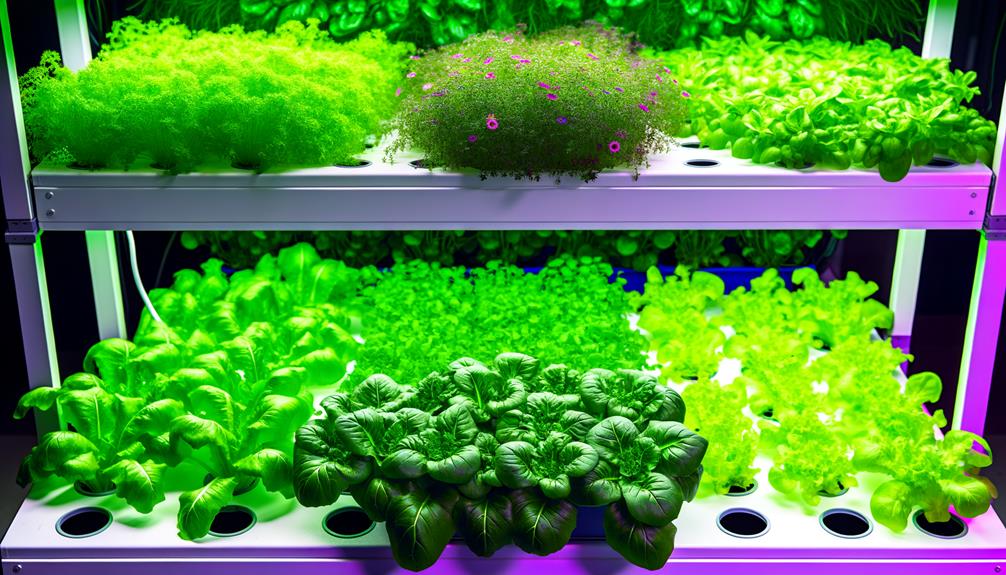
After assembling the necessary equipment, the selection of appropriate plant species is paramount for maximizing the efficiency and yield of a hydroponic system.
Empirical studies suggest that certain plants thrive better in hydroponic environments due to their specific physiological traits.
Key factors to evaluate include:
- Growth rate: Fast-growing plants like lettuce and spinach can provide quicker returns.
- Root structure: Plants with smaller root systems, such as herbs, are more suited to hydroponic conditions.
- Nutrient uptake: Species that efficiently absorb nutrients, such as tomatoes, often show higher yields.
These variables critically influence the success and productivity of hydroponic cultivation, making informed plant selection essential. By carefully considering factors such as nutrient availability, water quality, and environmental conditions, growers can optimize their yields and ensure healthy plant development. Growing plants in hydroponics allows for precise control over these variables, reducing the risk of soil-borne diseases and enhancing overall efficiency. Selecting suitable plant varieties further maximizes the benefits of hydroponic systems, leading to higher productivity and sustainability.
Light Requirements
Adequate light supply is critical for the photosynthetic efficiency and overall growth of plants in a hydroponic system.
Research demonstrates that most hydroponic plants require light intensity levels between 400-700 µmol/m²/s for peak photosynthesis.
Full-spectrum LED lights are often preferred due to their energy efficiency and ability to mimic natural sunlight.
Studies indicate that red and blue wavelengths are particularly effective, with red light enhancing flowering and blue light promoting vegetative growth.
Photoperiodism also plays a role; typically, 14-18 hours of light per day are recommended for most hydroponic crops.
Insufficient light can lead to stunted growth and diminished yields, underscoring the necessity of precise light management in hydroponic environments.
Water Management
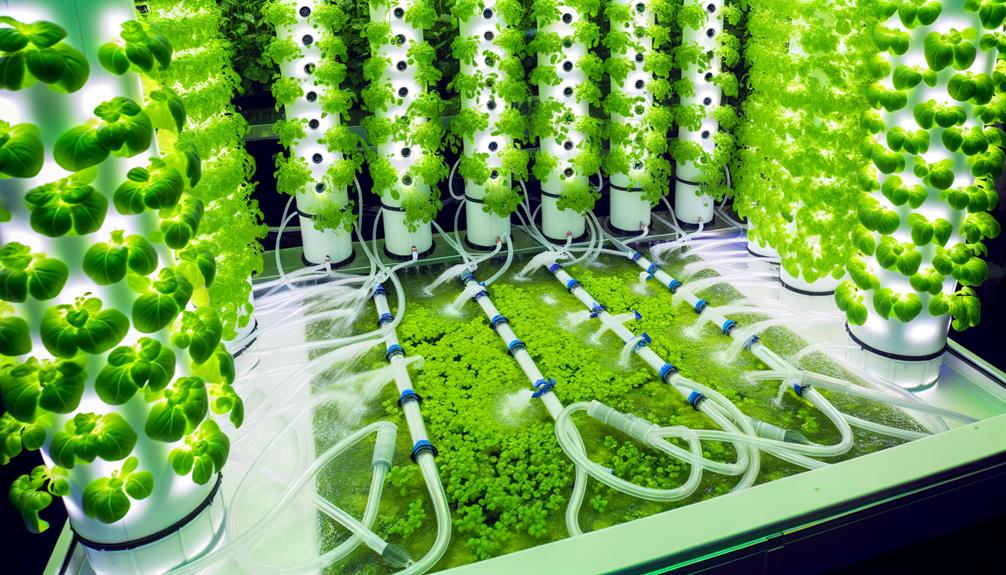
Effective water management is crucial for maximizing nutrient delivery and maintaining plant health in hydroponic systems. Proper water management guarantees that plants receive the correct balance of nutrients and oxygen, which maximizes growth and yields.
Key aspects include:
- pH Levels: Maintaining a pH between 5.5 and 6.5 is critical for nutrient availability.
- Electrical Conductivity (EC): Regular monitoring of EC helps guarantee ideal nutrient concentration in the solution.
- Water Temperature: Keeping water temperature between 65-75°F prevents root diseases and promotes nutrient uptake.
Data-driven approaches to these factors lead to more predictable and robust hydroponic outcomes.
Common Challenges
One of the most significant challenges in hydroponic gardening is maintaining the ideal balance of nutrients, pH, and environmental conditions to prevent plant stress and disease.
Research indicates that even minor deviations in nutrient concentration can lead to nutrient deficiencies or toxicities, hampering plant growth (Santos et al., 2021).
pH levels need to be meticulously controlled within a narrow range—typically between 5.5 and 6.5—to optimize nutrient uptake (Jones, 2017).
Additionally, environmental factors such as light, temperature, and humidity must be consistently regulated.
Failure to do so can result in issues like root rot or powdery mildew, which can devastate crops.
Advanced monitoring systems and regular adjustments are essential to mitigate these common challenges effectively.
Urban Farming Applications
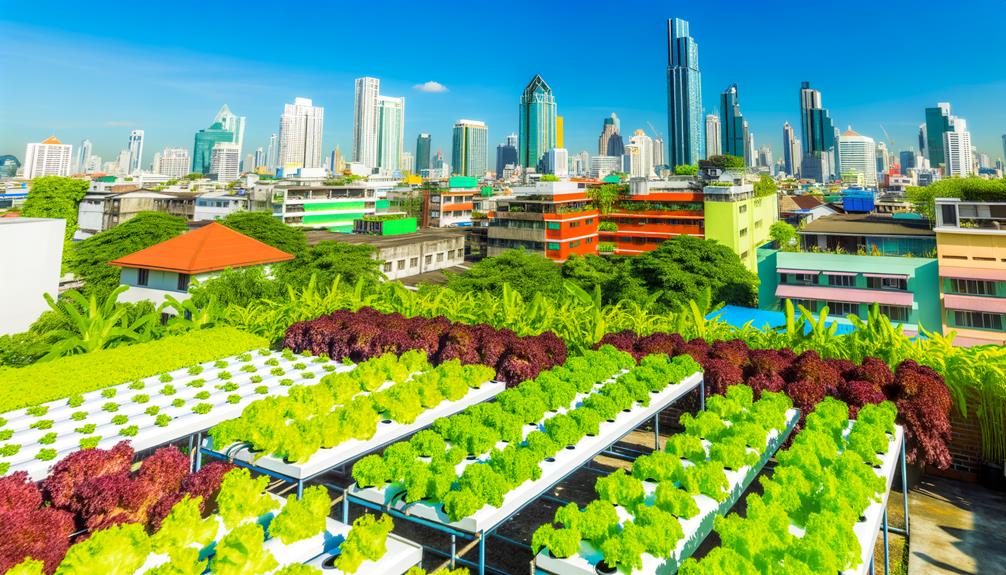
Urban farming applications of hydroponics demonstrate significant space efficiency benefits, utilizing vertical farming techniques to maximize limited urban spaces.
Research indicates hydroponic systems can reduce water usage by up to 90% compared to traditional soil-based agriculture, highlighting their sustainability.
Additionally, urban hydroponic farms can decrease food transportation distances, contributing to reduced carbon emissions and fresher produce for city dwellers.
Space Efficiency Benefits
How can hydroponics considerably enhance space efficiency in urban farming applications? By eliminating the need for soil, hydroponics allows for vertical stacking and denser planting arrangements, making it highly suitable for urban environments where space is a premium. Empirical studies show that hydroponic systems can yield up to 4-6 times more produce per square foot compared to traditional soil gardening.
Key space efficiency benefits include:
- Vertical Farming: Utilizes multi-layered structures to maximize vertical space.
- Compact Systems: Requires less horizontal space, ideal for rooftop or indoor farming.
- Optimized Growth Conditions: Enables precise control over nutrient delivery, leading to faster growth and higher yields.
Sustainability and Resources
Hydroponic systems greatly contribute to sustainability by minimizing water usage, reducing the need for chemical fertilizers, and decreasing the carbon footprint associated with traditional agriculture.
Studies indicate that hydroponic farming uses up to 90% less water compared to soil-based methods, owing to recirculation techniques.
Additionally, nutrient delivery in hydroponics is highly controlled, ensuring efficient uptake by plants and reducing fertilizer runoff by up to 60%.
Urban farming applications can capitalize on these benefits, transforming underutilized spaces into productive green areas.
By facilitating local food production, hydroponics also cuts down on transportation emissions, further contributing to environmental sustainability.
The integration of renewable energy sources can enhance these benefits, making hydroponic urban farms a cornerstone of modern sustainable agriculture.
Future of Hydroponics
Advancements in technology and increasing global food demands are driving significant innovations in the future of hydroponics. Emerging trends focus on enhancing efficiency, sustainability, and scalability to meet these challenges.
Key developments include:
- Automation and Artificial Intelligence (AI): Enhancing precision in nutrient delivery, environmental controls, and crop monitoring.
- Vertical Farming: Maximizing space utilization, especially in urban environments, to produce higher yields per square meter.
- Energy-efficient Lighting: Utilizing LED technology to reduce energy consumption while providing ideal light spectra for plant growth.
These innovations promise to revolutionize agricultural practices, ensuring a sustainable and reliable food supply for the future.
Conclusion
Hydroponics, the science of cultivating terrestrial plants in nutrient solutions, presents a confluence of technological innovation and agricultural necessity.
The myriad types of hydroponic systems offer significant benefits, including efficient water management and urban farming applications.
Essential equipment and strategic plant selection are crucial for optimizing growth.
Despite common challenges, the future of hydroponics is promising, driven by advancements in technology and growing environmental concerns.
Coincidentally, as urbanization accelerates, hydroponics emerges as a crucial solution for sustainable agriculture.

